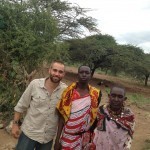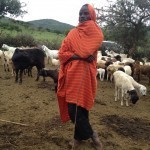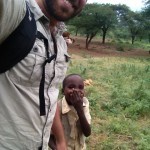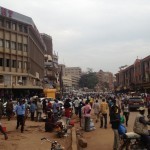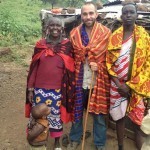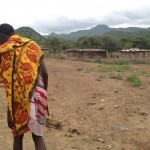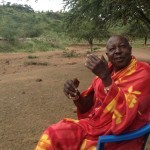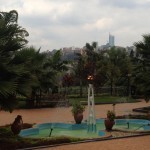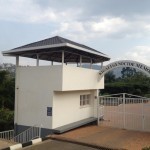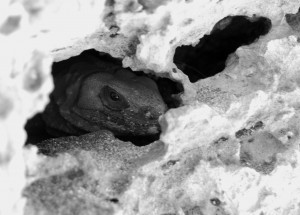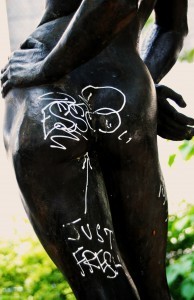Rolf Potts's Blog, page 85
August 1, 2012
Book review: Dancing in the fountain by Karen McCann
Vagablogging :: Rolf Potts Vagabonding Blog
Dancing in the Fountain how to enjoy living abroad written by Karen McCann 
Now available in print and on e-reader, August 2012
“Living abroad is an opportunity to reinvent yourself that rarely exists outside the witness protection program.” ~Karen McCann
From their first date, Karen and her husband-to-be, Rich talked about living abroad. Instead–after getting married–they moved to Cleveland, Ohio for two decades. Yet during a vacation en-route to Italy they stopped to visit a friend in Seville, Spain. One visit led to another and eventually Karen, Rich along with their dog, Pie went to live in Southern Spain for a year. But like many of us who have a notion our wanderlust will be curbed with one epic adventure—one year has turned into many. The couple splits their time between Spain and San Anselmo, California, USA.
Dancing in the Fountain gives a warm, humorous account of fitting together life’s puzzle pieces regardless of surface. Karen McCann slowly wiggles her way into a Spanish community where friendships are nurtured “since baptism” by befriending tapas owners (and attempting to understand what they are saying) along with reawakening her love for painting. She makes shopping for a screw driver sound like a grand adventure especially when language pronunciation happens to be slightly off; and adopts the local health care ways for lowering cholesterol —wine, chocolate and ham. Throughout the book you’ll not only come to know her expat town but also laugh at Cleveland snake wrangling and her dog getting drunk after sneaking a whole rum cake!
Karen encourages fitting-in by learning the local language and adorning the areas fashion—perhaps even down to a haircut. She also states that when you live in a destination city “people visit you” (though the trick might be getting them to leave). In her chapter “Culture Lag” she talks about the necessity of mentally unpacking when waltzing between homes splint by 9 time zones and a very different view on the beloved Spanish practice of a siestas.
So how did the title of the book come about you wonder…
“Late one blazing hot night, I was returning home from a club meeting and passed through Duck Plaza to find Rich and L-F sitting in folding chairs with their feet up on the rim of the duck fountain, sipping scotch from a little silver flask…After a while, we took off our shoes and began dipping our toes in the cool water. Then Rich planted his feet in the fountain and stood up…Rich, who can never resist a movie moment, swept me into his arms and began to waltz me around.”
Eventually a local “old curmudgeon” passed by and growled, “’You wouldn’t do that back where you come from!’”–which she found to be true. Traveling lends oneself to live out loud.

author & painter, Karen McCann
Original article can be found here: Book review: Dancing in the fountain by Karen McCann
July 30, 2012
Do you visit one place over and over again?
Vagablogging :: Rolf Potts Vagabonding Blog

Multiple Bolivia entry stamps in a passport. Photo: Henrique Bente / Flickr
An Internet meme going around is about five guys who took the same photo for 30 years. These were friends who would vacation together at Copco Lake. What started as a lark turned into a regular tradition: the group of people, the poses and facial expressions stayed constant.
Reading that story prompted me to wonder if I’ve ever done anything like that. Then I realized I had. When I lived in Taiwan, I would often make visa runs to Hong Kong to apply for a new Taiwanese visa. My pattern would be:
Stay at the Yes Inn hostel at Fortress Hill. Once I found a clean hostel that wasn’t in the Chungking Mansions and on Hong Kong Island, I stuck with it.
Eat gyros chicken kebabs with garlic sauce at Ebeneezer’s.
Go hip-hop dancing with my local HK friend Bruce at Club No. 9.
I probably went through that pattern a half-dozen times, if not more. Funny how you fall into habits without being aware of it. Doing those things became part of my regular Hong Kong routine.
Have you visited the same place with the same friends on multiple occasions? Do you have a personal ritual you like to re-enact? Please share your stories in the comments.
Original article can be found here: Do you visit one place over and over again?
July 29, 2012
Some days the best plan for travel is not having a plan
Vagablogging :: Rolf Potts Vagabonding Blog
“I hit the streets every day with no real plan besides walking and seeing what happens or taking a taxi across town and finding my way back. Or I look out the top of the hotel and see an area and say, okay, I’m going there today—that slum, that village. I go through souks and bazaars and stores. People come up and ask, “My friend, what are you doing here?” My icebreaker is, “I’m here to meet you.””
–Henry Rollins, “Punk Rock World Traveler,” World Hum, November 2, 2011
Original article can be found here: Some days the best plan for travel is not having a plan
July 28, 2012
Vagabonding Field Report: slowing down in Salta la linda, Argentina
Vagablogging :: Rolf Potts Vagabonding Blog
Cost/day: £20
What’s the strangest thing you’ve seen lately?
 Cowboys, everywhere – or gauchos as they are called here. It isn’t a daily occurrence, but every now and then a whole bunch will sweep into town and ride around, dressed up to the nines complete with fancy hats and tassels. They look spectacular.
Cowboys, everywhere – or gauchos as they are called here. It isn’t a daily occurrence, but every now and then a whole bunch will sweep into town and ride around, dressed up to the nines complete with fancy hats and tassels. They look spectacular.
Describe a typical day:
My boyfriend and I have been here for a month now, and we’re here mainly to get some work done (Steve is editing a feature documentary and I’m writing/making websites). We’ve rented an apartment looking onto the mountains and that’s our work base. Everything closes here from around 1-5pm. Even the surgeons go home to be with their families. It’s a beautifully relaxed pace of life. We go for walks around the pretty, cobbled town, shop in the local market, and sometimes go up the mountain to take in the sweeping views. Nighttime for us is quiet, although sometimes we might catch some live folklorico music at the local Casona de Molina.
Describe an interesting conversation you had with a local:
We have been doing some volunteering with an organisation called CloudHead. One day we helped out on a project teaching media skills to teenagers from a poorer part of town. The kids were discussing things that were important to them and things they couldn’t understand about the world. Despite many of them being in their early teens, their sensitivity to their surroundings was wonderful. They were concerned about children who had no homes, and people throwing rubbish in nature. Most of all, they believed that they could help change these things. My favourite quote was from a 14-year-old girl who said “Together we can change everything, but first we have to start with ourselves. If we can’t change ourselves then we can’t do anything.”
What do you like about where you are? Dislike?
Steve and I have fallen in love with Salta. It’s nicknamed ‘Salta la Linda’ (Salta the pretty) and its obvious to see why. The white buildings with terracotta roofs on cobbled streets, combine with the surrounding mountains to make a charming and magnificent setting. As I mentioned before, the pace of life is mellow and the people are wonderfully friendly. It’s different to other cities we’ve been to in Argentina as its much closer to the Bolivian border and has a more obvious indigenous presence. In some ways, it reminds us of a much quieter version of Cusco in Peru. It isn’t touristy but it bustles with local activity. As for things we don’t like, that’s difficult. There’s not a lot of vegetarian food, but the empanadas more than make up for that!
Describe a challenge you faced:
 We’ve been a little in the wars since we got here. I had a throat infection and then Steve burnt himself quite badly on the sauna. Luckily we had our Red Cross first aid app, which came to the rescue! I wrote the app when working at the Red Cross last year so it was great to actually use it.
We’ve been a little in the wars since we got here. I had a throat infection and then Steve burnt himself quite badly on the sauna. Luckily we had our Red Cross first aid app, which came to the rescue! I wrote the app when working at the Red Cross last year so it was great to actually use it.
What new lesson did you learn?
Beware of wet, slippery floors in saunas!
Where next?
We’re here for another week and then heading to Cafayate for a few days before leaving Argentina and heading to San Pedro de Atacama. After that, we’re off to Bolivia and some incredibly cold temperatures!
You can follow our journey on our blog Bridges and Balloons.
Original article can be found here: Vagabonding Field Report: slowing down in Salta la linda, Argentina
Vagabonding Field Report: slowing down in ‘Salta la linda’, Argentina
Vagablogging :: Rolf Potts Vagabonding Blog
Cost/day: £20
What’s the strangest thing you’ve seen lately?
 Cowboys, everywhere – or gauchos as they are called here. It isn’t a daily occurrence, but every now and then a whole bunch will sweep into town and ride around, dressed up to the nines complete with fancy hats and tassels. They look spectacular.
Cowboys, everywhere – or gauchos as they are called here. It isn’t a daily occurrence, but every now and then a whole bunch will sweep into town and ride around, dressed up to the nines complete with fancy hats and tassels. They look spectacular.
Describe a typical day:
My boyfriend and I have been here for a month now, and we’re here mainly to get some work done (Steve is editing a feature documentary and I’m writing/making websites). We’ve rented an apartment looking onto the mountains and that’s our work base. Everything closes here from around 1-5pm. Even the surgeons go home to be with their families. It’s a beautifully relaxed pace of life. We go for walks around the pretty, cobbled town, shop in the local market, and sometimes go up the mountain to take in the sweeping views. Nighttime for us is quiet, although sometimes we might catch some live folklorico music at the local Casona de Molina.
Describe an interesting conversation you had with a local:
 We have been doing some volunteering with an organisation called CloudHead. One day we helped out on a project teaching media skills to teenagers from a poorer part of town. The kids were discussing things that were important to them and things they couldn’t understand about the world. Despite many of them being in their early teens, their sensitivity to their surroundings was wonderful. They were concerned about children who had no homes, and people throwing rubbish in nature. Most of all, they believed that they could help change these things. My favourite quote was from a 14-year-old girl who said “Together we can change everything, but first we have to start with ourselves. If we can’t change ourselves then we can’t do anything.”
We have been doing some volunteering with an organisation called CloudHead. One day we helped out on a project teaching media skills to teenagers from a poorer part of town. The kids were discussing things that were important to them and things they couldn’t understand about the world. Despite many of them being in their early teens, their sensitivity to their surroundings was wonderful. They were concerned about children who had no homes, and people throwing rubbish in nature. Most of all, they believed that they could help change these things. My favourite quote was from a 14-year-old girl who said “Together we can change everything, but first we have to start with ourselves. If we can’t change ourselves then we can’t do anything.”
What do you like about where you are? Dislike?
Steve and I have fallen in love with Salta. It’s nicknamed ‘Salta la Linda’ (Salta the pretty) and its obvious to see why. The white buildings with terracotta roofs on cobbled streets, combine with the surrounding mountains to make a charming and magnificent setting. As I mentioned before, the pace of life is mellow and the people are wonderfully friendly. It’s different to other cities we’ve been to in Argentina as its much closer to the Bolivian border and has a more obvious indigenous presence. In some ways, it reminds us of a much quieter version of Cusco in Peru. It isn’t touristy but it bustles with local activity. As for things we don’t like, that’s difficult. There’s not a lot of vegetarian food, but the empanadas more than make up for that!
Describe a challenge you faced:
 We’ve been a little in the wars since we got here. I had a throat infection and then Steve burnt himself quite badly on the sauna. Luckily we had our Red Cross first aid app, which came to the rescue! I wrote the app when working at the Red Cross last year so it was great to actually use it.
We’ve been a little in the wars since we got here. I had a throat infection and then Steve burnt himself quite badly on the sauna. Luckily we had our Red Cross first aid app, which came to the rescue! I wrote the app when working at the Red Cross last year so it was great to actually use it.
What new lesson did you learn?
Beware of wet, slippery floors in saunas!
Where next?
We’re here for another week and then heading to Cafayate for a few days before leaving Argentina and heading to San Pedro de Atacama. After that, we’re off to Bolivia and some incredibly cold temperatures!
You can follow our journey on our blog Bridges and Balloons.
Original article can be found here: Vagabonding Field Report: slowing down in ‘Salta la linda’, Argentina
July 27, 2012
Vagabonding Field Report: Rwanda, Uganda and Kenya by bus
Vagablogging :: Rolf Potts Vagabonding Blog
Cost/day: $30/day
What’s the strangest thing you’ve seen lately?
After spending several months in Africa, I have seen a lot of strange things and it has all begun to be quite normal. Therefore, the contrast of Kigali, Rwanda was actually the strangest thing I have seen in a while. The streets were impeccably clean, everything was organized and you couldn’t find corruption anywhere. The harassing street hawkers weren’t trying to sell me the same worthless junk or “Made in China” African statues and masks like everywhere else, but rather USB sticks, Oxford English dictionaries and Economist magazines. Compared to the past few months, this was very strange!
Describe a typical day:
On most days, I met with a handful of young African entrepreneurs, start-up incubators, businesses and local investment funds. I would spend most of the day commuting around town on the back of a boda-boda motorcycle taxi to meet with these individuals and organizations. I would always try to squeeze in random sites and attractions along the way when I had time.
Describe an interesting conversation you had with a local:
I spent an afternoon with a Maasai family in Kenya. The father of the family had four wives and forty children. Two of the wives, and their children, lived in a series of huts in a remote part of Kenya. I spent time a day with them and they explained some of their customs to me (one of the sons happened to know some English), gave me tea with milk from one of their goats and asked me plenty of questions about America and Europe.
What do you like about where you are? Dislike?
The people could not be more friendly, hospitable and excited to have a visitor. It made me feel extremely welcome and I wanted to immediately pass on that attitude to everyone I encountered.
I disliked the very weak power grid in many of the places. Normally I would never care about this, but since I am working remotely and have to be connected to my business, it made it difficult for me when the power and internet would randomly go out without warning.
Describe a challenge you faced:
Inspired by my failed attempt to storm the Burj Al Arab a couple field reports ago (Dubai and the world’s most extravagant, well, everything), I decided to successfully infiltrate the Rwanda Stock Exchange. My strategy was to look like I was in a hurry, like I knew where I was going and if anyone asked, throw out a lot of finance talk and seem very frustrated that they delayed something so obviously important. As I approached the only tall building in Kigali, the mission appeared to work perfectly. But to my disappointment, no one seemed to care. Someone eventually greeted me by the stairwell with a smile and asked where I was headed. I responded and they simply pointed me in the right direction. I walked right in and walked around until someone introduced themselves and proceeded to show me around the small exchange with only four companies.
What new lesson did you learn?
The best way to see Africa is with an all-terrain vehicle. You can easily travel between countries and major cities by bus, but when you look out the window, you realize how much you miss along the way and will have no way of exploring if you didn’t have a car to take you there. I want to come back and see Africa (and the world rather) like this guy: 23 year / 50,000 Mile Road Road Trip.
Where next?
Not sure yet, but I’m heading to the States for a little while and then probably Southeast Asia after that. If interested, you can follow my trip on Facebook, Twitter or my blog.
Original article can be found here: Vagabonding Field Report: Rwanda, Uganda and Kenya by bus
July 26, 2012
Crime Wave press: Asian based thriller publisher looks for submissions!
Vagablogging :: Rolf Potts Vagabonding Blog
 I recently got word that a new independent publisher is trying to kick the corporate media world’s bum by releasing hard hitting, pulpy noirs with Asian settings. I am talking about Crime Wave Press based in Hong Kong and brainchild of travel and Asian focused writer Tom Vater. The first two books are his own works of fiction. The first, “The Devil’s Road to Khatmandu”, is the grungy comeback of four infamous hippy trail beaters to the crime scene in a changed contemporary Nepal. A drug deal gone bad in the past swings back to the present like a high altitude Himalayan trek on acid, leaving no prisoners. The second novel, “The Cambodian Book of the Dead”, is the first episode of Detective Meier’s adventures: sent on the hunt for the heir to a coffee empire in Cambodia, the German private eye will get entangled with a crazy war criminal whose hideous career spans back to Nazi Germany and collides to the present of a nation recovering fast from genocide…
I recently got word that a new independent publisher is trying to kick the corporate media world’s bum by releasing hard hitting, pulpy noirs with Asian settings. I am talking about Crime Wave Press based in Hong Kong and brainchild of travel and Asian focused writer Tom Vater. The first two books are his own works of fiction. The first, “The Devil’s Road to Khatmandu”, is the grungy comeback of four infamous hippy trail beaters to the crime scene in a changed contemporary Nepal. A drug deal gone bad in the past swings back to the present like a high altitude Himalayan trek on acid, leaving no prisoners. The second novel, “The Cambodian Book of the Dead”, is the first episode of Detective Meier’s adventures: sent on the hunt for the heir to a coffee empire in Cambodia, the German private eye will get entangled with a crazy war criminal whose hideous career spans back to Nazi Germany and collides to the present of a nation recovering fast from genocide…
If you love Asia and pulp like I do, these two books should definitely become part of your Kindle’s top 10, as they are easily available through Amazon.com as eBooks.
I decided to reach Tom Vater, the man in the dark hat, to ask some more questions about his books and Crime Wave press…
First of all, I wanted to know more about the genesis of Crime Wave Press and how it situates among the current publishing market. Tom answered that “Crime Wave Press is a Hong Kong based fiction imprint that endeavors to publish the best new crime novels from Asia and about Asia to readers around the globe. I think it makes perfect sense to start this kind of publishing venture in the current economic climate. The large traditional book publishers, like the large record labels before them, are either on the way out or need to find new business models. Countless writers are putting out their own titles as eBooks these days but have no idea how to market them, how to get reviews, even how to package their work attractively. We step into the breach and feel that there are great opportunities for small companies with good know-how. My partner Hans Kemp has been running a successful publishing venture – Visionary World – from Hong Kong for many years and knows the ins and outs of putting books on the market intimately. I bring my long experience of writing about Asia, and I know a thing or two about crime fiction and how the media works. Beyond wanting to provide a platform for new talent in Asia, Crime Wave Press is also great fun. Finding talented writers is a hugely rewarding process. And we will be partying at Ubud’s Writers and Readers Festival in Bali in October and then move to the Frankfurt book fair to introduce Crime Wave Press to a larger audience. Any writers out there who have a crime novel with an Asian focus or location, get in touch via http://www.crimewavepress.com/”

Tom Vater in Phnom Penh - picture by Conor Wall
I asked Tom, an affirmed travel writer, why he decided to move to fiction writing with a travel setting, and I got a clear answer: “I write non-fiction, journalism and fiction. I have made my living from writing for a decade and a half and found out in the early days that doing just one thing is not enough to make a decent living. Writers are paid so little, I don’t see how one can survive without working across the entire industry. The common thread here is that I mostly write about Asia. But yes, I have expanded my focus by starting a publishing company, Crime Wave Press. A new venture into new territory! And it’s fun!”
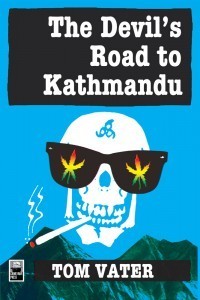 My curiosity was particularly sparkled by The Devil’s Road to Khatmandu, a pulp thriller with the infamous Hippy Trail as a background for the action. I asked Tom why he decided to talk about such a mysterious, “romantic” way of traveling which has become impossible these days. Tom answered that when he first came to Asia in the early 90s, he “met a bunch of people who had done that overland trip many times in the 1970s. They told me wonderful stories and I wanted to write something about the changing nature of travel at the time. And yes, there was something incurably romantic about it, perhaps because these guys were old hippies and I was young and felt, naturally, that something had been lost, with Lonely Planet et al arriving on the scene. One of these guys said that the difference between a tourist and a traveler is that the traveler does not know when his journey will end. He then set off riding a horse across Africa for three years”.
My curiosity was particularly sparkled by The Devil’s Road to Khatmandu, a pulp thriller with the infamous Hippy Trail as a background for the action. I asked Tom why he decided to talk about such a mysterious, “romantic” way of traveling which has become impossible these days. Tom answered that when he first came to Asia in the early 90s, he “met a bunch of people who had done that overland trip many times in the 1970s. They told me wonderful stories and I wanted to write something about the changing nature of travel at the time. And yes, there was something incurably romantic about it, perhaps because these guys were old hippies and I was young and felt, naturally, that something had been lost, with Lonely Planet et al arriving on the scene. One of these guys said that the difference between a tourist and a traveler is that the traveler does not know when his journey will end. He then set off riding a horse across Africa for three years”.
Of course, I wanted to know if he too had attempted the overland Europe to Asia route before writing about it. “I traveled from Kathmandu to Istanbul overland in 1998 and did other sections of the overland trail at various times. The long trip took about three months – fantastic experience. Witnessing the US play Iran during the 1998 football world cup, in a hotel in Esfahan, was a highlight I later wrote about – and I ended up playing a match with a small team of other travelers against local security forces on the world’s largest square! I Pakistan was gloriously lawless at that time, long before becoming politicized by 9/11, and I had a great adventure up in the North West around Peshawar. A lot of the material and characters in The Devil’s Road to Kathmandu were taken from that trip. I stayed for some time in the Swat Valley, now so infamous for its insecurity and violence”
If you want to read some fast-paced, intense pulp stories set into your favorite Asian backdrops, you better keep an eye open on Crime Wave Press’s dirty deeds. And remember that they are looking for submission at the moment, so get in touch with them if you have the guts!!
Original article can be found here: Crime Wave press: Asian based thriller publisher looks for submissions!
July 25, 2012
Photograph the details of your life
Vagablogging :: Rolf Potts Vagabonding Blog
Technology has made it easier to take pictures. Cameras have gotten more compact. Snapping a postcard perfect picture at the edge of the Grand Canyon will later jog your memory of that moment but so could a google image search keywords “grand canyon.”
I say that not to discourage the classical snap shots of iconic places–I’ve taken plenty over the years–but to encourage you to be creative and capture the details of your life.
Here are some examples:
All three of the pictures below are from heavily visited areas which draw multitudes of people each year.
These next two were misadventures…taken at destination places.
All five images illustrate what caught my attention at those moments. Yet don’t really give clues about the location.
A fellow beach goer was eager to point out the lizard in the cliff at Tulum Ruins. Another hiker ahead of me at Canyonlands National Park drew the smiley face in the mud. Someone–or possibly two people–wrote on the butt of that parks statue in Paris. The healing wound is my horses skin two months after being attacked by a bear in Alaska. And the shredded tire brings back the smell of burnt rubber in Moab.
Do you have a detail image of your life you’d like to share? Please visit our Facebook page, upload a photo and tell us a little about it.
Original article can be found here: Photograph the details of your life
July 23, 2012
How Tim Ferriss and Silicon Valley techies hack their trips
Vagablogging :: Rolf Potts Vagabonding Blog
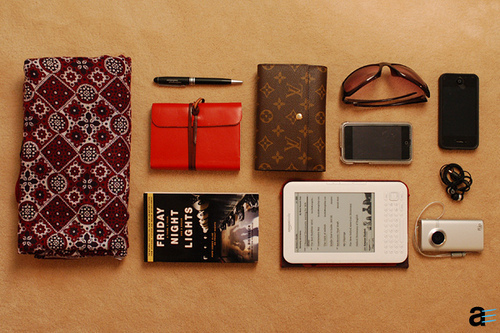
Packing light. Photo: Amina Elahi / Flickr
Business travelers, also known as “road warriors,” are some of the most experienced trip hackers around. Although here at Vagabonding we espouse slower wandering, these hard-core types have streamlined the process to a science. Their advice appeared in this New York Times article: How the tough get going: Silicon Valley travel tips. Prominently featured in the article is Tim Ferriss, known as the author of “The 4-Hour Workweek” and the “The 4-Hour Body.”
Naturally, there are many websites and apps that get mentioned. It’s interesting to see these guys apply a hacker ethic of “lighter, faster, more efficient” to their journeys.
My favorite tip was how to get a new charger and adapter fast if you lose yours. Ask your hotel to see their “lost and found” box. If you’re staying at a place that gets a lot of businesspeople, a lot of those things get accidentally left behind.
The CLEARcard was new to me. This enables cardholders to pass through airport security faster. While it’s a useful tool, a quick check of their website reveals that the card can only be used in four airports. If the card were more widely accepted, it would be more handy.
I did research, and found Global Entry. This is a U.S. Customs and Border Protection (CBP) program that can help members speed through security. Global Entry has been deployed in many major American airports, making it far more convenient than CLEARcard.
Some of the advice was risky though, like packing a starter pistol and declaring the firearm to TSA, as a way of making sure airport staff don’t lose your bag. With security being a big concern these days, this is not something I would recommend to anyone.
How do you pack light for your trips? Any tips for speeding up the check-in and boarding process? Please share your thoughts in the comments.
Original article can be found here: How Tim Ferriss and Silicon Valley techies hack their trips
July 22, 2012
Elias Canetti on the mysteries of haggling
Vagablogging :: Rolf Potts Vagabonding Blog
“In the souks, however, the price that is named first is an unfathomable riddle. No one knows in advance what it will be, not even the merchant, because in any case there are many prices. Each one relates to a different situation, a different customer, a different time of day, a different day of the week. There are prices for single objects and prices for two or more together. There are prices for foreigners visiting the city for a day and prices for foreigners who have been here for three weeks. There are prices for the poor and prices for the rich, those for the poor of course being the highest. One is tempted to think that there are more kinds of prices than there are kinds of people in the world.”
–Elias Canetti, The Voices of Marrakesh: A Record of a Visit (1968)
(1968)
Original article can be found here: Elias Canetti on the mysteries of haggling
Rolf Potts's Blog
- Rolf Potts's profile
- 323 followers


